(RETURN)
SAIL Volume I
5. WOOL CLIPPERS
ANTIOPE (1866-1921),
1,443 registered tons, length 243ft 3ins, beam 38ft 4ins, depth 23ft
7in. Of iron
construction, built by Reid, Glasow for
Joseph Heap's Thames & Mersey Line. She was a large and strong
vessel of her
time. She carried emigrants and
general cargo from Liverpool to Melbourne, and often carried
horses to
Calcutta or Madras, and jute and other Indian products back
to Liverpool. In 1868, she made
her best
passage to Melbourne
of 68 days. In 1883, The Thames & Mersey Line was sold
to the Beazley
interests and
her voyages became less regular. She is
not listed as in the Wool Fleet by Basil Lubbock
between
1874-1890. She was sold in 1897 and for some years in th South American
trade. In the
Russo-Japanese
War,she was
captured by the Japanese under Russian colours. The Japanese sold her
to
a firm in
British Columbia for the timber trade. In 1914, when
World War I started, she was in a New
Zealand port
serving as a coal
hulk. She was brought out of retirement and refurbished. In
1916, she went
ashore in
southern New Zealand was salvaged and again
refurbished. She then carried coal from
Newcastle,
N.S.W. to Chile. In 1921, the vessel caught fire in Algoa Bay, South
Africa, and after some
repairs and
beecame a store ship for
a sugar company in Beira, Mozambique after a career of fifty-five
years.
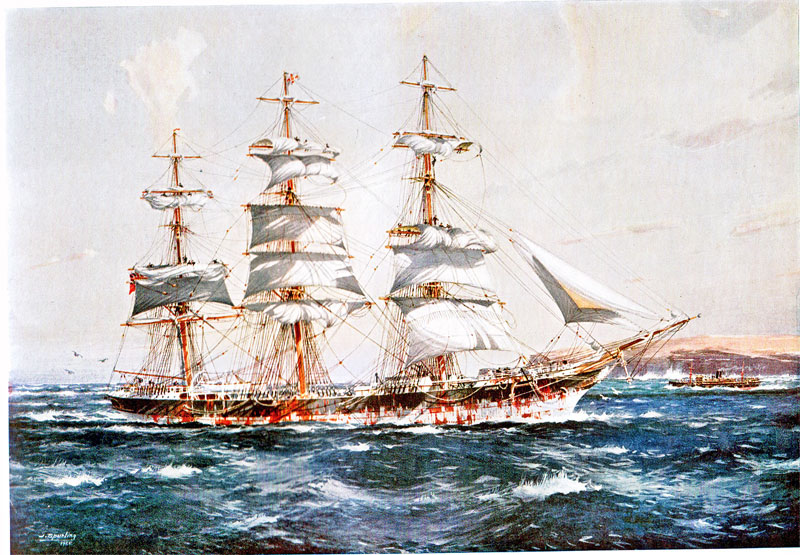
MERMERUS (1872-1909), 1,671 registered
tons, length
264ft 2in,, beam 39ft 8in, depth 23ft 7in
Constructed of
iron, built by
Barclay, Curle
& Co, Clyde, for A. & J.H. Carmichael's Golden Fleece
Line.
She was specially built for the wool trade and in the records of
the
annual
sailings of the Wool
Fleet
from1873 to 1890 (in Basil Lubbock's "The
Colonia Clippers") the MERMERUS was absent
in
only
two years (1874/75 and 1876/77). In her 1874/75 voyage she
carried a cargo to Sydney, then
loaded coal for
San Francisco,
and brought a cargo of wheat back from there. In her 1876/77
passage
she carried a
cargo of gun powder to Melbourne in 69
days. . On all the other occasions she sailed
from Melbourne
with
a cargo of wool and came to be regarded there as a
reliable fixture in the trade.
Her Last voyage
to Melbourne was in 1897
after which she was sold to Russian owners.who kept
her in the
Australian trade. Her end came in December1909 when she went ashore in
a heavy fog
10 miles from
Christian sand having left
Frederikstad (Norway) with a cargo f timber for Melbourne.
She
was badly damaged and was sold to the ship breakers..
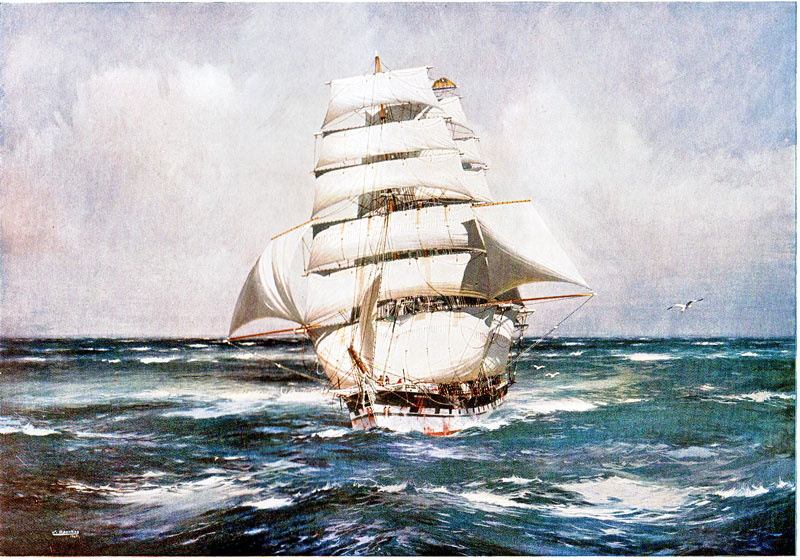
LOCH ETIVE (1877-1913),
1,235 registered tons, length 226ft 9in, beam 39ft 9in, depth
21ft 6in. Of iron
construction,
built by J.&A.
Inglis, Glasgow,
for Aitken, Lilburn's General Shipping Co. (or Loch
Line as it
was commonly
called). Joseph Conrad served on her
as
third mate and wrote about it in "Mirror of the Sea".
She was heavily
rigged to begin with but in 1904 was cut down to a barque.
She was put in the Sydney trade
but sometimes
went to Melbourne. On her
first voyage she went to Calcutta for a retur cargo of
jute.Her
outward and
homeward passages averaged about ninety days. From
Australian ports she would return with
wool or
wheat..Between 1877 and 1890, the only year she is listed with the wool
fleet was in 1882 from
Sydney. Up to
1911, shcontinued
to load cargoes to Adelaide , Melbourne and Sydney. She was sold
to
French owners
in 1911 and had disappeared
from the registry in
1914..
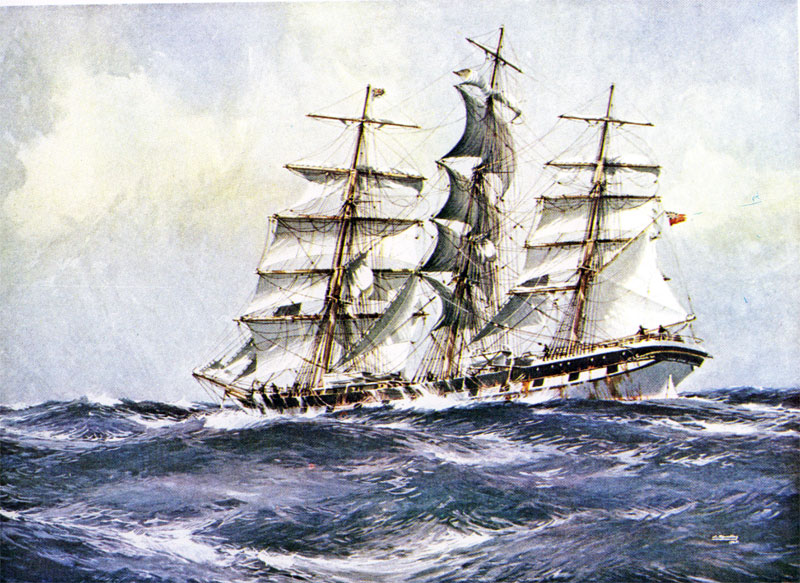
BRILLIANT (1877-1916),
1,613 registered tons, length 254ft 8in, beam 39ft 7in, depth 24ft 2in.
Of iron
construction
built by Duthie &
Co, Aberdeen, for J.Duthie,
Sons & Co. She had a smart appearance with
black sides and
and with
a brass bulwark rails along the
length of the ship. Like all Duthie
ships she was in
the Sydney
trade via the Cape of Good Hope and
returning around the Horn. The
Aberdeen White Star
clipper
PERICLES was `built in the same yard alongside her and there was an
intense rivalry between them.
The latter
tending to win the
outward passages loaded mainly with passengers while BRILLIANT had a
full
cargo
but losing on the
return with BRILLIANT
loaded with wool. She is listed by Basil Lubbock in "The
Colonial
Clippers" in th Wool Fleet from Sydney
between 1877-1890 on
five occasions - 1880-81,
1885-86, 1887-88, She often
however loaded over 8,000 bails of wool
right up 1904-05 when she
was
sold to Italian
owners and renamed NOSTRA SIGNORA DEL
CARMINE. In 1916, boundfor Genoa
with
a cargo of coal from
Norfolk, Virginia,.she was surprised by a submarine and sunk in the
Gulf of Lions
after the crew
had taken to
the boats and towed
towards land by the submarine.
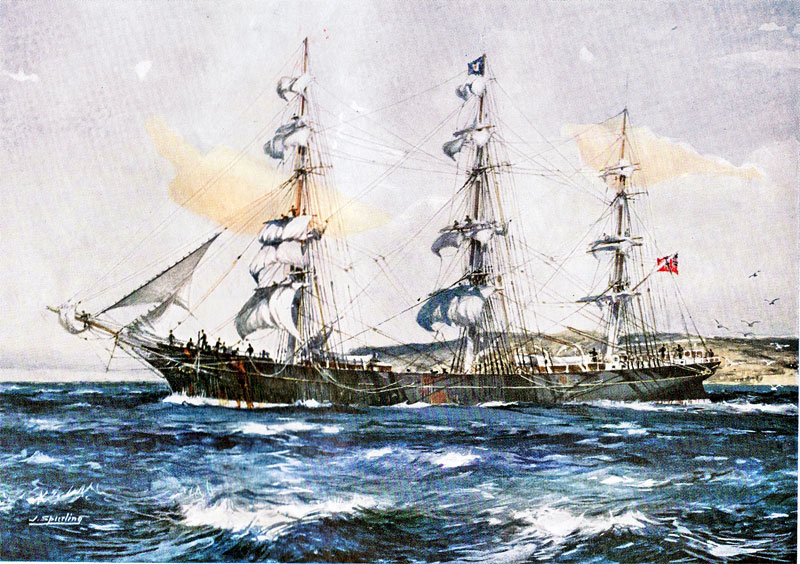
PERICLES (1877-1923),
1,598 registered tons, length 259ft 9 in, beam 39ftm 4in, depth 25ft
iin.. Constructed
of iron by
Duthie & Co, Aberdeen, for George
Thompson's Aberdeen White Star Line. She was one of the last
passenger
sailing ships built for the Australian trade.
Built alongside
BRILLIANT, she had a 56ft long poop
stretching
beyond
the mizzen mast. In ten voyages to Sydney the average passage
time
was was 84 days. After
Sydney, in 1882
she went to Calcutta for a
cargo of jute for New York, and she made several trips
to San
Francisco to
pick up wheat cargoes.. In 1904, she was sold to
Norwegian owners who reduced her sail plan and
used her
for carrying timber to Melbourne.. She continued her steady voyaging
without incident through World
War I with a
name
change to SJURSO. She was sold to the ship breakers in 1923.
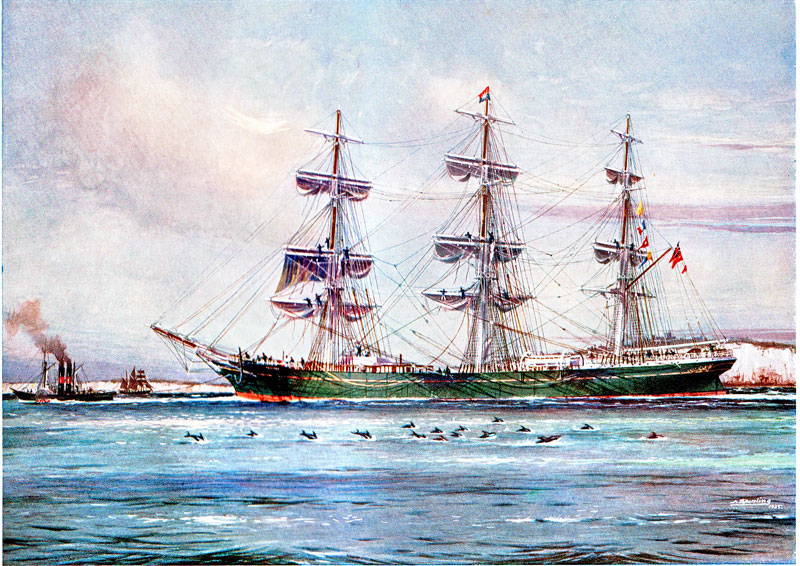
CIMBA (1878-1916), 1,174 registered tons,
length
223ft, beam 34ft 6in, depth 21ft 7in.. Of iron
construction,
built by Hood, Aberdeen, for Alexander
Nichol & Co, and was designed for the
Australian wool
trade.
Her sail plan had width rather than height. Fast in light
winds she
required
careful
handling in strong wind. However, she consistently ran
over 300 miles in the 23 1/2 hour days
of her
eastings.
Her passages out and home were uniformly good. She made 29
voyages under
Nichol's
ownership - twenty-four to Sydney, two to
Brisbane, one to Newcastle, N.S.W., one to
Rockhampton,
QLD, In
Basil Lubbock's "Colonial Clippers", CIMBA is
listed as being in the Wool
Fleet from
Sydney for every year from
1877-78 to 1889-89 except one (1882-83).. in her later years
she
was twice unable (1901 and 1903) to get a wool cargo and had to cross
the Pacific to South
America to get
a cargo for the return
voyage. In 1906, with the death of her owner, she was sold to
Norwegian
owners who used her in the timber trade. She is believed
to have been wrecked in 1916.
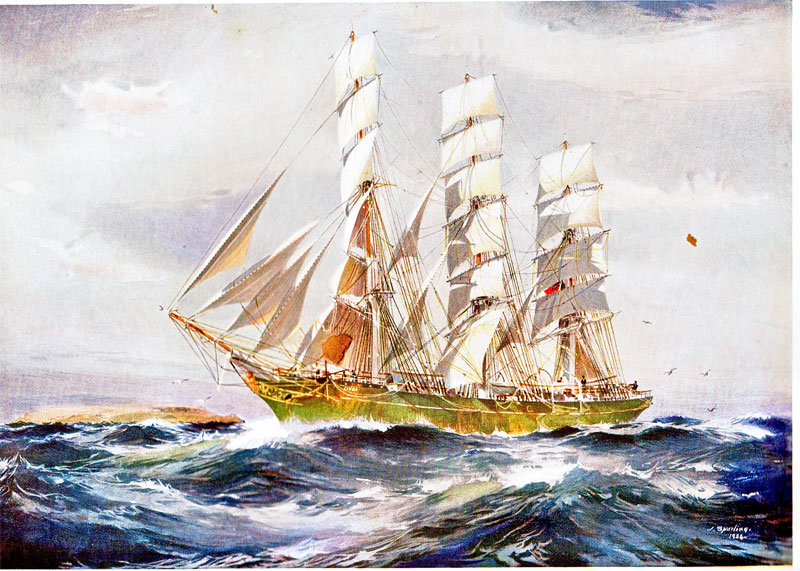
LOCH TORRIDON
(1881-1915), 2000 tons burden, length 287ft 4in, beam 42ft 6in,
depth 24ft.. Of
iron
construction, built by Barclay,
Curle, Glasgow for
Aitken, Lilburn's General Shipping Co. Rigged as
a four masted
barque.
In the mid 1870s, the need for bigger
ships to handle the cargoes from San Francisco,
Melbourne ,
Sydney,
Chittagong and other ports led to the development of fourmasted
sailing ships. LOCH
TORRIDON and
LOCH MOIDART were the Loch
Line of Glasgow's response to this development..
Basil
Lubbock
comments that the LOCH TORRIDON 'became famous as
one of the most perfect four mast
barques ever
built."
Among other innovations, the sails on all three masts were
intercahangeable. In early
voyages, she
carried horses from Melbourne to
Calcutta., In subsequent voyages she went to San Francisco,
then did five
voyages from Australia with wool. In a number of
voyages from the United Kingdom her passage
times to
Melbourne were
under 80 days. She was sold to Russian owners in 1913.In
January in 1915, while
off the west
coast of Ireland with a tmber
cargo she was abandoned because of a leak.
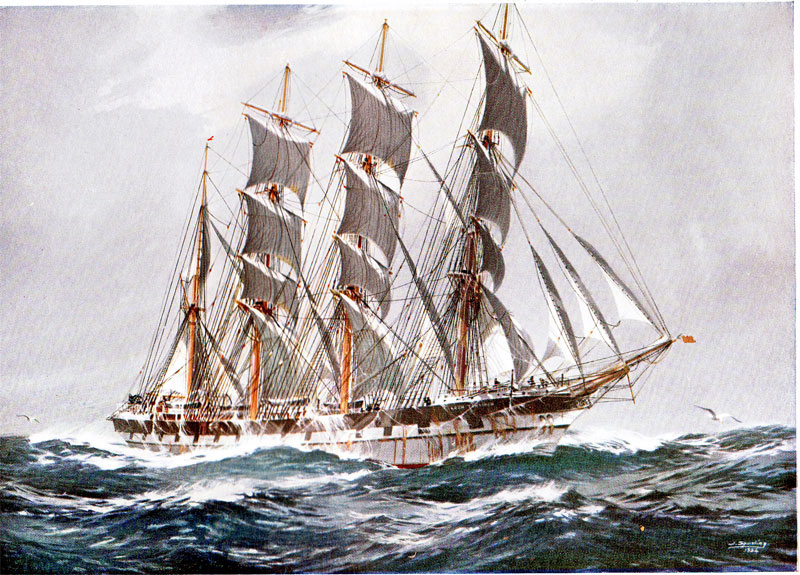
PORT JACKSON (1882-1917),
2132 registered tons, length 286ft 2in, beam 41ft 1in, depth 25ft
2in..
Of iron
construction, built by Hall,
Aberdeen for
Duthie Bros. A four masted barque, she was intended for
the Australian
trade and was designed by
Alexander Duthie. On her
maiden voyage she reached Sydney
from the
Channel in 77 days and was
the first four master to make the voyage in under 80
days..She made
regular
passages to and from Australia without incident
until she caught fire in Sydney in May, 1893. The
fire was
contained but extensive repairs took close to six months before
she loaded wool at Newcastle,
N.S.W., and
began her return journey
in November 1893. She continued her regular voyages to Australia
until 1904 when
she was laid up in the Thames for two years.
In 1906, she was purchased by Devitt &
Moore for their
cadet
training scheme. Cadets were taken on voyages over aperiod of
seven
years. At
the outbreak of
World War I, she was laid up at Grimsby.
She was brought back into service and carried
cargoes in
round trips to Buenos Aires, New York and Adelaide. Then in
ballast to Buenos Aires where
she loaded
wheat toreturn to Great
Britain. In April 1917 she was sunk without warning by a
submarine.
her crew took
to the boats, The mate and 14 men were rescued
but the captain and 12 others were not.
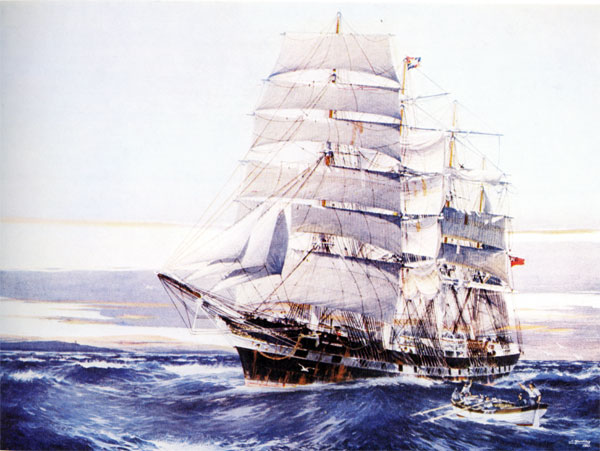
MOUNT STEWART (1891 -
1925), 1903 registered tons, length 271ft 6in, beam
40ft 1in, depth23ft 4in.
Of steel
construction, built by
Barclay,
Curle, Glasgow for Carmichael's Golden Fleece Line. She and her
sister
ship Cromdale were the last two sailing ships built specifically
for the Australian
wool trade. She
survived
World War I and while she could get a return
cargo of wool or wheat she kept going. In 1922/23,
she was laid up
for a year at Milford
Haven. She made a last voyage from Liverpool to Sydney, then from
Newcastle, NSW,
to Iquique, Chile, from where in 1925 she went to the ship-breakers at
Nantes.
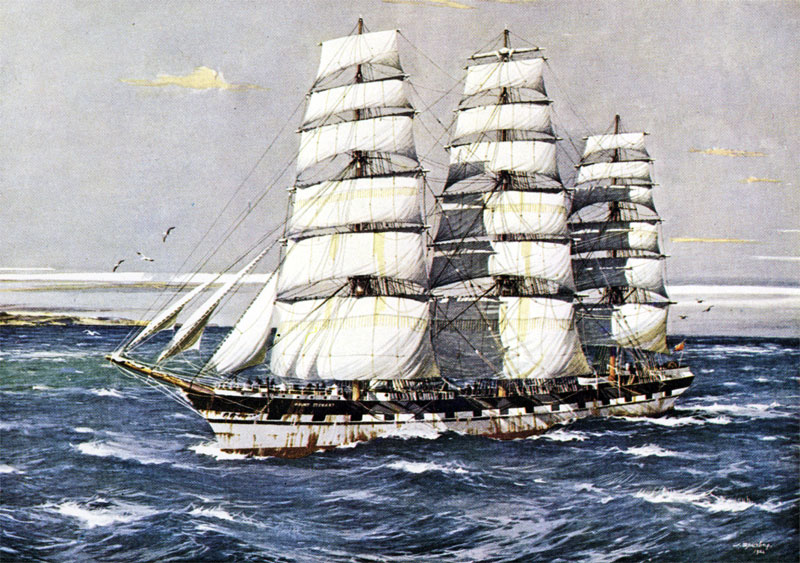
(RETURN)








